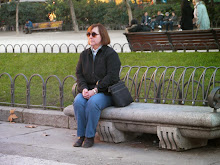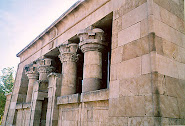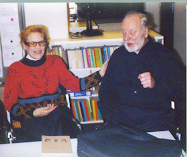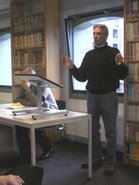 From TWIC, results of the Women's Senior CC, October 28 - November 9, 2008. Here is a link to the final cross-table for the Women's standings. The women's countries were not listed in the final cross-table at the official website, which is really stupid! I want to know where the players were from without having to check at FIDE player lists for each one individually. Photo from official website: WFM Tamara Vilerte, 2008 Women's Seniors CC winner. Top three Women's Senior CC finishers:
1 Vilerte,Tamara WFM 8 51.5
2 Strutinskaya,Galina WIM 7.5 52
3 Fomina,Tatyana WIM 7.5 45
From TWIC, results of the Women's Senior CC, October 28 - November 9, 2008. Here is a link to the final cross-table for the Women's standings. The women's countries were not listed in the final cross-table at the official website, which is really stupid! I want to know where the players were from without having to check at FIDE player lists for each one individually. Photo from official website: WFM Tamara Vilerte, 2008 Women's Seniors CC winner. Top three Women's Senior CC finishers:
1 Vilerte,Tamara WFM 8 51.5
2 Strutinskaya,Galina WIM 7.5 52
3 Fomina,Tatyana WIM 7.5 45
Saturday, November 29, 2008
2008 World Seniors' Chess Championship
 From TWIC, results of the Women's Senior CC, October 28 - November 9, 2008. Here is a link to the final cross-table for the Women's standings. The women's countries were not listed in the final cross-table at the official website, which is really stupid! I want to know where the players were from without having to check at FIDE player lists for each one individually. Photo from official website: WFM Tamara Vilerte, 2008 Women's Seniors CC winner. Top three Women's Senior CC finishers:
1 Vilerte,Tamara WFM 8 51.5
2 Strutinskaya,Galina WIM 7.5 52
3 Fomina,Tatyana WIM 7.5 45
From TWIC, results of the Women's Senior CC, October 28 - November 9, 2008. Here is a link to the final cross-table for the Women's standings. The women's countries were not listed in the final cross-table at the official website, which is really stupid! I want to know where the players were from without having to check at FIDE player lists for each one individually. Photo from official website: WFM Tamara Vilerte, 2008 Women's Seniors CC winner. Top three Women's Senior CC finishers:
1 Vilerte,Tamara WFM 8 51.5
2 Strutinskaya,Galina WIM 7.5 52
3 Fomina,Tatyana WIM 7.5 45
Are Basque Relics Frauds?
 Story from the Guardian.co.uk
Oh no. (Calvary image from June, 2006)
Finds that made Basques proud are fake, say experts
Giles Tremlett in Madrid
Monday November 24 2008 00.01 GMT
It was hailed as an archeological discovery of global importance showing, among other things, the oldest representation of Christ on the cross and proof that ancient Egyptian influences had survived deep in Roman Spain.
For traditional Basques the pictures, symbols and words found scraped onto pieces of third century pottery dug up near the town of Nanclares, in northern Spain, included miraculous evidence that their unique language of Euskara was far older than ever thought.
Eighteen months ago the dig's director, Eliseo Gil, claimed that some finds at the Roman town known as Veleia were on par with those at Pompeii or Rome itself. Basque nationalists bristled with pride. This archeological jewel gave them a far greater claim to a distinctive, millennial and Christian culture than they had dreamed possible.
Now a committee of experts has revealed those jewels to be fakes. "They are either a joke or a fraud," said Martín Almagro, a professor in prehistory from Madrid. "How has something like this been taken seriously for so long?" [Who are these experts? Are they Spanish? Are they Basque? Are they of other nationalities who do not have regional politics as their number one agenda???]
The hunt is on for an archeological fraudster who defaced fragments of third century pottery with fake graffiti. [An assumption not yet proven].
The fraudster seems either to have buried the pieces or planted them in a laboratory where experts sifted through finds. [Really?] The fakes left the first people to see them swooning.
The Calvary scene was hailed as both the nearest thing mankind had to a contemporary pictorial account of the crucifixion, and proof that Basques had been relatively early Christians.
The words in Euskera, if genuine, would have predated by 700 years the previous earliest known written form of the language. The hieroglyphics caused speculation about the existence of third century Egyptologists [oh please - why use such a loaded word "Egyptologist" - why is it not possible that third century Egyptians who were Coptic Christians were in the area at the time? We know there was long-term trade between Egypt and Spain dating back thousands of years] who might have created the inscriptions to teach children.
Now experts who have studied the pieces in depth say the fakes, some of which used modern glue [Was modern glue simply used to hold pieces of shards together? Why would this make the inscriptions a fraud?], should have rung warning bells immediately.
References were found to non-existent gods [really? If these gods were not know before from prior references, how do these experts know they are non-existent?], 19th-century names [again, really? place names always present complications in archaeological digs but are often used to substantiate other evidence of antiquity] and even to the 17th-century philosopher Descartes [note that no quotes were provided to substantiate this claim].
Words in Euskara used impossible spellings. [Really? Who are these experts in this ancient language? Have they ever studied ancient spellings in English? The variety of spellings is amazing! Indeed, I believe that in English for instance, standardized spellings weren't established until the 20th century!] The hieroglyphs included references to Queen Nefertiti which would have been almost impossible to make prior to the 19th century. [Really? If the people who were doing the inscriptions had actual knowledge, then it wouldn't be so unusual; it's just us so-called modern westerners who didn't have knowledge of Queen Neftertiti until the 19th century; that doesn't mean other people prior to our time didn't know about her. That's a really arrogant assumption to make, tsk tsk.]
The Calvary scene, meanwhile, included the inscription "RIP". "It is a formula that can only be applied to people who are dead," Almagro told El Correo newspaper. "To say that Jesus Christ is dead would be a heresy. I haven't seen anything quite so funny in the whole history of Christianity." [Well, I don't know about that; Christ actually did die on that cross, otherwise the whole premise of Christianity, i.e., that Christ rose from the dead 3 days after he died, would be a big lie! What else would people put in a Calvary scene representing where Christ died, but RIP?]
Local authorities and sponsors from Basque public companies have poured hundreds of thousands of euros into excavations. Last week they closed the dig temporarily. Eliseo Gil did not return calls from the Guardian but sources said those in charge were not yet fully convinced that their finds were fake.
Story from the Guardian.co.uk
Oh no. (Calvary image from June, 2006)
Finds that made Basques proud are fake, say experts
Giles Tremlett in Madrid
Monday November 24 2008 00.01 GMT
It was hailed as an archeological discovery of global importance showing, among other things, the oldest representation of Christ on the cross and proof that ancient Egyptian influences had survived deep in Roman Spain.
For traditional Basques the pictures, symbols and words found scraped onto pieces of third century pottery dug up near the town of Nanclares, in northern Spain, included miraculous evidence that their unique language of Euskara was far older than ever thought.
Eighteen months ago the dig's director, Eliseo Gil, claimed that some finds at the Roman town known as Veleia were on par with those at Pompeii or Rome itself. Basque nationalists bristled with pride. This archeological jewel gave them a far greater claim to a distinctive, millennial and Christian culture than they had dreamed possible.
Now a committee of experts has revealed those jewels to be fakes. "They are either a joke or a fraud," said Martín Almagro, a professor in prehistory from Madrid. "How has something like this been taken seriously for so long?" [Who are these experts? Are they Spanish? Are they Basque? Are they of other nationalities who do not have regional politics as their number one agenda???]
The hunt is on for an archeological fraudster who defaced fragments of third century pottery with fake graffiti. [An assumption not yet proven].
The fraudster seems either to have buried the pieces or planted them in a laboratory where experts sifted through finds. [Really?] The fakes left the first people to see them swooning.
The Calvary scene was hailed as both the nearest thing mankind had to a contemporary pictorial account of the crucifixion, and proof that Basques had been relatively early Christians.
The words in Euskera, if genuine, would have predated by 700 years the previous earliest known written form of the language. The hieroglyphics caused speculation about the existence of third century Egyptologists [oh please - why use such a loaded word "Egyptologist" - why is it not possible that third century Egyptians who were Coptic Christians were in the area at the time? We know there was long-term trade between Egypt and Spain dating back thousands of years] who might have created the inscriptions to teach children.
Now experts who have studied the pieces in depth say the fakes, some of which used modern glue [Was modern glue simply used to hold pieces of shards together? Why would this make the inscriptions a fraud?], should have rung warning bells immediately.
References were found to non-existent gods [really? If these gods were not know before from prior references, how do these experts know they are non-existent?], 19th-century names [again, really? place names always present complications in archaeological digs but are often used to substantiate other evidence of antiquity] and even to the 17th-century philosopher Descartes [note that no quotes were provided to substantiate this claim].
Words in Euskara used impossible spellings. [Really? Who are these experts in this ancient language? Have they ever studied ancient spellings in English? The variety of spellings is amazing! Indeed, I believe that in English for instance, standardized spellings weren't established until the 20th century!] The hieroglyphs included references to Queen Nefertiti which would have been almost impossible to make prior to the 19th century. [Really? If the people who were doing the inscriptions had actual knowledge, then it wouldn't be so unusual; it's just us so-called modern westerners who didn't have knowledge of Queen Neftertiti until the 19th century; that doesn't mean other people prior to our time didn't know about her. That's a really arrogant assumption to make, tsk tsk.]
The Calvary scene, meanwhile, included the inscription "RIP". "It is a formula that can only be applied to people who are dead," Almagro told El Correo newspaper. "To say that Jesus Christ is dead would be a heresy. I haven't seen anything quite so funny in the whole history of Christianity." [Well, I don't know about that; Christ actually did die on that cross, otherwise the whole premise of Christianity, i.e., that Christ rose from the dead 3 days after he died, would be a big lie! What else would people put in a Calvary scene representing where Christ died, but RIP?]
Local authorities and sponsors from Basque public companies have poured hundreds of thousands of euros into excavations. Last week they closed the dig temporarily. Eliseo Gil did not return calls from the Guardian but sources said those in charge were not yet fully convinced that their finds were fake.
Friday, November 28, 2008
Book Reveals Harsh Reality of Arabic Women
Blue Eyed Mummy and Cannabis in Ancient Chinese Grave
 I had no idea that most strains of cannabis today originated in China! Fascinating article - and more of those troublesome blue-eyed certainly Caucasian mummies (this one was most likely a shaman) showing up in the far northwest region of China. [Map - shows how close Turpan a/k/a Turfan is to Urumchi a/k/a Urumqi - see prior posts under Mummies of Urumchi: (1) (2)].
Story from The Canadia Press.com
Researchers find oldest-ever stash of marijuana
1 day ago
OTTAWA — Researchers say they have located the world's oldest stash of marijuana, in a tomb in a remote part of China.
The cache of cannabis is about 2,700 years old and was clearly "cultivated for psychoactive purposes," rather than as fibre for clothing or as food, says a research paper in the Journal of Experimental Botany.
The 789 grams of dried cannabis was buried alongside a light-haired, blue-eyed Caucasian man, likely a shaman of the Gushi culture, near Turpan in northwestern China.
The extremely dry conditions and alkaline soil acted as preservatives, allowing a team of scientists to carefully analyze the stash, which still looked green though it had lost its distinctive odour.
"To our knowledge, these investigations provide the oldest documentation of cannabis as a pharmacologically active agent," says the newly published paper, whose lead author was American neurologist Dr. Ethan B. Russo.
Remnants of cannabis have been found in ancient Egypt and other sites, and the substance has been referred to by authors such as the Greek historian Herodotus. But the tomb stash is the oldest so far that could be thoroughly tested for its properties.
The 18 researchers, most of them based in China, subjected the cannabis to a battery of tests, including carbon dating and genetic analysis. Scientists also tried to germinate 100 of the seeds found in the cache, without success.
The marijuana was found to have a relatively high content of THC, the main active ingredient in cannabis, but the sample was too old to determine a precise percentage.
Researchers also could not determine whether the cannabis was smoked or ingested, as there were no pipes or other clues in the tomb of the shaman, who was about 45 years old.
The large cache was contained in a leather basket and in a wooden bowl, and was likely meant to be used by the shaman in the afterlife.
"This materially is unequivocally cannabis, and no material has previously had this degree of analysis possible," Russo said in an interview from Missoula, Mont.
"It was common practice in burials to provide materials needed for the afterlife. No hemp or seeds were provided for fabric or food. Rather, cannabis as medicine or for visionary purposes was supplied."
The tomb also contained bridles, archery equipment and a harp, confirming the man's high social standing.
Russo is a full-time consultant with GW Pharmaceuticals, which makes Sativex, a cannabis-based medicine approved in Canada for pain linked to multiple sclerosis and cancer.
The company operates a cannabis-testing laboratory at a secret location in southern England to monitor crop quality for producing Sativex, and allowed Russo use of the facility for tests on 11 grams of the tomb cannabis.
Researchers needed about 10 months to cut red tape barring the transfer of the cannabis to England from China, Russo said.
The inter-disciplinary study was published this week by the British-based botany journal, which uses independent reviewers to ensure the accuracy and objectivity of all submitted papers.
The substance has been found in two of the 500 Gushi tombs excavated so far in northwestern China, indicating that cannabis was either restricted for use by a few individuals or was administered as a medicine to others through shamans, Russo said.
"It certainly does indicate that cannabis has been used by man for a variety of purposes for thousands of years."
Russo, who had a neurology practice for 20 years, has previously published studies examining the history of cannabis.
"I hope we can avoid some of the political liabilities of the issue," he said, referring to his latest paper.
The region of China where the tomb is located, Xinjiang, is considered an original source of many cannabis strains worldwide.
Copyright © 2008 The Canadian Press. All rights reserved.
I had no idea that most strains of cannabis today originated in China! Fascinating article - and more of those troublesome blue-eyed certainly Caucasian mummies (this one was most likely a shaman) showing up in the far northwest region of China. [Map - shows how close Turpan a/k/a Turfan is to Urumchi a/k/a Urumqi - see prior posts under Mummies of Urumchi: (1) (2)].
Story from The Canadia Press.com
Researchers find oldest-ever stash of marijuana
1 day ago
OTTAWA — Researchers say they have located the world's oldest stash of marijuana, in a tomb in a remote part of China.
The cache of cannabis is about 2,700 years old and was clearly "cultivated for psychoactive purposes," rather than as fibre for clothing or as food, says a research paper in the Journal of Experimental Botany.
The 789 grams of dried cannabis was buried alongside a light-haired, blue-eyed Caucasian man, likely a shaman of the Gushi culture, near Turpan in northwestern China.
The extremely dry conditions and alkaline soil acted as preservatives, allowing a team of scientists to carefully analyze the stash, which still looked green though it had lost its distinctive odour.
"To our knowledge, these investigations provide the oldest documentation of cannabis as a pharmacologically active agent," says the newly published paper, whose lead author was American neurologist Dr. Ethan B. Russo.
Remnants of cannabis have been found in ancient Egypt and other sites, and the substance has been referred to by authors such as the Greek historian Herodotus. But the tomb stash is the oldest so far that could be thoroughly tested for its properties.
The 18 researchers, most of them based in China, subjected the cannabis to a battery of tests, including carbon dating and genetic analysis. Scientists also tried to germinate 100 of the seeds found in the cache, without success.
The marijuana was found to have a relatively high content of THC, the main active ingredient in cannabis, but the sample was too old to determine a precise percentage.
Researchers also could not determine whether the cannabis was smoked or ingested, as there were no pipes or other clues in the tomb of the shaman, who was about 45 years old.
The large cache was contained in a leather basket and in a wooden bowl, and was likely meant to be used by the shaman in the afterlife.
"This materially is unequivocally cannabis, and no material has previously had this degree of analysis possible," Russo said in an interview from Missoula, Mont.
"It was common practice in burials to provide materials needed for the afterlife. No hemp or seeds were provided for fabric or food. Rather, cannabis as medicine or for visionary purposes was supplied."
The tomb also contained bridles, archery equipment and a harp, confirming the man's high social standing.
Russo is a full-time consultant with GW Pharmaceuticals, which makes Sativex, a cannabis-based medicine approved in Canada for pain linked to multiple sclerosis and cancer.
The company operates a cannabis-testing laboratory at a secret location in southern England to monitor crop quality for producing Sativex, and allowed Russo use of the facility for tests on 11 grams of the tomb cannabis.
Researchers needed about 10 months to cut red tape barring the transfer of the cannabis to England from China, Russo said.
The inter-disciplinary study was published this week by the British-based botany journal, which uses independent reviewers to ensure the accuracy and objectivity of all submitted papers.
The substance has been found in two of the 500 Gushi tombs excavated so far in northwestern China, indicating that cannabis was either restricted for use by a few individuals or was administered as a medicine to others through shamans, Russo said.
"It certainly does indicate that cannabis has been used by man for a variety of purposes for thousands of years."
Russo, who had a neurology practice for 20 years, has previously published studies examining the history of cannabis.
"I hope we can avoid some of the political liabilities of the issue," he said, referring to his latest paper.
The region of China where the tomb is located, Xinjiang, is considered an original source of many cannabis strains worldwide.
Copyright © 2008 The Canadian Press. All rights reserved.
Shopping on Black Friday!
Thursday, November 27, 2008
The Saga of the Whipped Sweet Potatoes
The Saga of Ka-Nefer-Nefer Continues
 The Saint Louis Art Museum Ka-Nefer-Nefer Egyptian Mask Saga Continues
Wed Nov 26, 2008 at 04:58:43 PM
A recent Associated Press article reports that the U.S. Department of Homeland Security is now looking into the provenance of the Ka-Nefer-Nefer mask, a 3,000-year-old Egyptian relic acquired in the late 1990s by the Saint Louis Art Museum.
The mask, said to date back to the Nineteenth Dynasty (1293-1185 B.C.), was unearthed early in 1952 by an up-and-coming Egyptian archaeologist named Mohammed Zakaria Goneim. It is at the center of a long-running ownership dispute between the art museum and the Egyptian government. The set-to was the topic of an in-depth Riverfront Times story by Malcolm Gay, "Out of Egypt," published in February 2006.
Wrote Gay:
The Saint Louis Art Museum Ka-Nefer-Nefer Egyptian Mask Saga Continues
Wed Nov 26, 2008 at 04:58:43 PM
A recent Associated Press article reports that the U.S. Department of Homeland Security is now looking into the provenance of the Ka-Nefer-Nefer mask, a 3,000-year-old Egyptian relic acquired in the late 1990s by the Saint Louis Art Museum.
The mask, said to date back to the Nineteenth Dynasty (1293-1185 B.C.), was unearthed early in 1952 by an up-and-coming Egyptian archaeologist named Mohammed Zakaria Goneim. It is at the center of a long-running ownership dispute between the art museum and the Egyptian government. The set-to was the topic of an in-depth Riverfront Times story by Malcolm Gay, "Out of Egypt," published in February 2006.
Wrote Gay:
Goneim announced to the world that he might have uncovered the untouched tomb of a previously unknown pharaoh named Sekhemkhet -- potentially the most significant find since Howard Carter unearthed the virgin tomb of Tutankhamen 30 years before. Among the many burials Goneim discovered atop the pyramid, one in particular caught his eye: the unmummified body of a woman, wrapped in a simple reed mat. Her remains, which dated to the Nineteenth Dynasty, were badly decomposed, but she wore an elaborate mask over her head and shoulders. Her face, covered by a thin sheet of blended copper and gold, peeked from beneath an intricate resin wig molded into plaits. The diadem that crowned her head was made of glass, as were her eyes and nipples. In each hand she held an amulet symbolizing strength and welfare; etched across her folded arms was a scene depicting the encounter between Osiris, the Egyptian god of the dead, and the woman's spiritual double in the afterlife, known as her ka. Goneim dubbed the woman Ka-Nefer-Nefer: the Twice-Beautiful Ka.The AP story updates the fight being waged by Zahi Hawass, secretary general for Egypt's Supreme Council of Antiquities, against the SLAM and its current director, Brent Benjamin. In the current story, Benjamin reiterates the argument he made to Gay in 2006 -- asserting that "[t]o date, we have not seen information that we believe is compelling enough to return the object." Counters Hawass, per the Associated Press: "This stupid man [Benjamin], he doesn't understand the rules here." Archaeologist Goneim, meanwhile, never achieved the worldwide fame his discovery had augured: In 1958 he was accused of looting artifacts, and though a friend and colleague came to the rescue with exculpatory evidence, he arrived too late. On January 12, 1959, Goneim threw himself into the Nile River and drowned.-Tom Finkel
3000 Year Old Kurdish King Burial?
 11/20/08
3,000-Year-Old Burial Ground Discovered in Kurdistan Province of Iran
Source: Iranian Cultural Heritage News Agency
A prehistoric burial ground has been discovered near the Iranian city of Sanandaj, which dates back to 3,000 years. Sanandaj is located in the western Kurdistan Province of Iran.
According to a report by the FARS News Agency, the 3,000 year-old cemetery was found during a road construction project, that is located 500 meters from the previously found ancient mound of Zagros.
Kurdistans provincial cultural heritage office confirmed that so far five squat burials have been found in the cemetery along with spears, bronze bracelets and earthenware.
Excavations, which started four days ago at the site, will continue for another week, reports from Press TV indicate.
Irans Kurdistan Province contains 218 natural, cultural, historical and religious sites including numerous historical villages. Ancient bridges, the Safavid Asef Divan monument and the Khosrowabad structure are among Kurdistans many tourist attractions.
11/20/08
3,000-Year-Old Burial Ground Discovered in Kurdistan Province of Iran
Source: Iranian Cultural Heritage News Agency
A prehistoric burial ground has been discovered near the Iranian city of Sanandaj, which dates back to 3,000 years. Sanandaj is located in the western Kurdistan Province of Iran.
According to a report by the FARS News Agency, the 3,000 year-old cemetery was found during a road construction project, that is located 500 meters from the previously found ancient mound of Zagros.
Kurdistans provincial cultural heritage office confirmed that so far five squat burials have been found in the cemetery along with spears, bronze bracelets and earthenware.
Excavations, which started four days ago at the site, will continue for another week, reports from Press TV indicate.
Irans Kurdistan Province contains 218 natural, cultural, historical and religious sites including numerous historical villages. Ancient bridges, the Safavid Asef Divan monument and the Khosrowabad structure are among Kurdistans many tourist attractions.
Armenian Gold Medalists Awarded State Medals
 State Awards of the Republic of Armenia to Chess Olympic Champions
27.11.2008 13:16
On November 26 the President of Armenia Serzh Sargsyan signed a decree on awarding Medals “For Services Contributed to the Motherland” of the first rank to the head coach of the men’s chess team of Armenia, International Grand master Arshak Petrosyan, International Grand Master Levon Aronyan, International Grand Master Vladimir Hakobyan, International Grand Master Artashes Minasyan, International Grand Master Tigran Petrosyan and International Grand Master Gabriel Sargsyan for their brilliant victory at the 38th Chess Olympiad, for properly presenting Armenia on the international arena, and promoting the development of chess in Armenia.
According to another presidential decree, Medals “For Services Contributed to the Motherland” of the second rank were awarded to Vice-Presidents of the Chess Federation of Armenia Levon Yolyan and Smbat Lputyan, businessman Artak Sargsyan, Director of the Chess House Hrachya Tavadyan for essential contribution to the development of chess in the republic.
State Awards of the Republic of Armenia to Chess Olympic Champions
27.11.2008 13:16
On November 26 the President of Armenia Serzh Sargsyan signed a decree on awarding Medals “For Services Contributed to the Motherland” of the first rank to the head coach of the men’s chess team of Armenia, International Grand master Arshak Petrosyan, International Grand Master Levon Aronyan, International Grand Master Vladimir Hakobyan, International Grand Master Artashes Minasyan, International Grand Master Tigran Petrosyan and International Grand Master Gabriel Sargsyan for their brilliant victory at the 38th Chess Olympiad, for properly presenting Armenia on the international arena, and promoting the development of chess in Armenia.
According to another presidential decree, Medals “For Services Contributed to the Motherland” of the second rank were awarded to Vice-Presidents of the Chess Federation of Armenia Levon Yolyan and Smbat Lputyan, businessman Artak Sargsyan, Director of the Chess House Hrachya Tavadyan for essential contribution to the development of chess in the republic.
Mary Ann Gomes on her Olympiad
Pourkashiyan Awarded GM Title
 I believe that's a WGM title - quite a difference, but still an achievement for Pourkashiyan. Congratulations!
Iran's Pourkashiyan awarded GM title
Thu, 27 Nov 2008 10:11:25 GMT
Iran's Woman International Master Atousa Pourkashiyan has been awarded the Grandmaster title at the 38th Chess Olympiad in Germany.
The Iranian national earned the title after she gained eight points in 11 games at the end of the Chess Olympiad in Dresden (Germany), IRIB quoted Iran's Chess Federation on Thursday.
Pourkashiyan won seven games and drew two others after competing with four grandmasters and five international masters during the event. In the second round, the Iranian chess master drew with Ukrainian Woman Grandmaster (WGM) Kateryna Lahno but managed to defeat all of her opponents in the next five games.
The world chess organization FIDE awards the title Grandmaster to exceptionally qualified chess masters. Apart from 'World Champion', Grandmaster is the highest title a chess player can attain. Once achieved, the title is held for life.
One hundred fifty-four countries took part in the 38th Chess Olympiad in Dresden, on November 12-25.
HRF/JG/MMN
I believe that's a WGM title - quite a difference, but still an achievement for Pourkashiyan. Congratulations!
Iran's Pourkashiyan awarded GM title
Thu, 27 Nov 2008 10:11:25 GMT
Iran's Woman International Master Atousa Pourkashiyan has been awarded the Grandmaster title at the 38th Chess Olympiad in Germany.
The Iranian national earned the title after she gained eight points in 11 games at the end of the Chess Olympiad in Dresden (Germany), IRIB quoted Iran's Chess Federation on Thursday.
Pourkashiyan won seven games and drew two others after competing with four grandmasters and five international masters during the event. In the second round, the Iranian chess master drew with Ukrainian Woman Grandmaster (WGM) Kateryna Lahno but managed to defeat all of her opponents in the next five games.
The world chess organization FIDE awards the title Grandmaster to exceptionally qualified chess masters. Apart from 'World Champion', Grandmaster is the highest title a chess player can attain. Once achieved, the title is held for life.
One hundred fifty-four countries took part in the 38th Chess Olympiad in Dresden, on November 12-25.
HRF/JG/MMN
A Modern Thanksgiving Story
Wednesday, November 26, 2008
2008 Chess Olympiad: Was Israel's Gold a Fluke?
"Buddha's Skull Found in Nanking?"
Red - CCC (Color of Choice for Cavemen)
Tuesday, November 25, 2008
Peruvian Finds Date Back to 3500 BCE
Big Funding Boost for "Internet Archaeology
2008 Chess Olympiad: Some Final Thoughts
- Kudos to GM Susan Polgar who did triple-duty - not only reporting information at her blog, but also serving as Chess Ambassador and English-Language Press Liason, as well as holding great interviews daily with players and personalities from the Olympiad. Thanks also to Paul Truong, the official photographer for this Olympiad, for his fantastic and candid photographs, round after round, from off days, the official opening, the official close, and everything in-between. I am appreciative of the great job that both Polgar and Truong did.
- I was very happy that Chessdom went back to its "live" blog for coverage of Round 11. I did not like the "live chat" experiment - most of the comments were boring, common, and disjointed. It was hard to follow what was going on. In the "live" blog, on the other hand, it was easy to follow the action as the time counted down toward the end of the games.
- The Week in Chess has set the standard ever since I've been online (December, 1998) and no doubt from before! Mark Crowthers lets nothing stand in his way of going the extra mile, whether it be going over games move by move to create and/or correct PGN notations or correctly identifying otherwise sometimes obscure players.
- I was very impressed with Chess Vibes - very current reports, great photographs and a slamming lay-out. How'd you do that?
- Europe E'checs provided much-needed information - in French (but they have English translation on some pages).
- Mig Greengard has such a wicked sense of humor! His Daily Dirt blog (part of Chess Ninja) provides much-needed insight and lots of laughs, but be warned: all types hang out there, compensated for with a collection of wits and sparkling commentators, most of whose commentary probably whizzes over the ignoramus heads of the thankfully relatively few a-holes. I believe (but have no proof) that a lot of chess femmes read the commentary there but generally refrain from commenting themselves - only a brave few every now and then wade in.
- Daaim Shabazz's The Chess Drum is a must-read for keen insights into the chess world in general and, in particular, for news about chess players that generally aren't covered elsewhere.
A few final thoughts: I'm still absolutely amazed that the American men were able to repeat their miracle Bronze performance from 2006 in 2008 Dresden! More incredible, at least to me, is the US Women's Team performance. I honestly did not think they had a prayer of winning a medal. I'm quite happy to say I was SO SO WRONG. And I will eat my wool beret tonight for supper. Hell, I need a new one anyway, this one was looking rather ratty...
I am absolutely convinced that what happened to the Russian Teams (Men - oh, I mean "Open" - and Women) was Divine Justice being meted out to Miniputin, the ass! LOL - do you hear laughter, Pharaoh er, Miniputin? That's the sound of millions of chess fans falling off their chairs and rolling on the floor busting a gut in hilarity at the performances of the oh-so-vaunted #1 ranked teams entering the Olympiad: Russian Men and Russian Women. Bwwwwwwwaaaaaaaaahhhhhhaaaaaaaa!
The Georgian Women won the Gold Medal The Georgian Women won the Gold Medal The Georgian Women won the Gold Medal
They're the only team other than USA and India I would care to see win the Gold. Sweet! Particularly Sweet since the Russian mobsters who put together the Women's World Chess Championship INSISTED that the female chessplayers of the world assemble in Nalchik, Russia, mere miles away from the GEORGIAN WAR ZONE after Russian invaded Georgia in August, 2008 a few weeks before the Championship was to convene. Those Russians particularly pooh-poohed the Georgian Women chessplayers' concerns - and the concerns of other Federations on behalf of their players - about sending their players to Nalchik.
Ha ha, Miniputin. The best is yet to come. Just watch what happens to your "vaunted" Ruble (Rubble?) in the coming months. Nothing personal against the players on the Russian chess teams - I suggest you emmigrate to Manhattan before President-Elect Obama takes office on January 20, 2009...
High Jinks at Politkovskaya Trial
Taliban Terrorists - Allah Will Spit in Their Faces for This
Southwest Chess Club of Hales Corners NEEDS HELP!
Testers Needed for a New Chess Game
2008 Chess Olympiad - NEWS FLASH
Monday, November 24, 2008
Kim Cattrall as Titian's Diana
 (Photo of Kim Cattrall, 2007, from the Do Something blog)
What a great story! I've never seen Sex in the City - not even in re-runs! I did add the recent movie to my Netflix list and it will be delivered in due course. I remember Cattrall for remarkable green eyes and being incredibly gorgeous and a good sport in "Big Trouble in Little China."
Cattrall recreates art masterpiece
4 hours ago
Sex And The City star Kim Cattrall has posed semi-naked in a recreation of Titian's masterpiece Diana and Actaeon.
BBC Two's The Culture Show challenged Tom Hunter to create a 21st century version of the painting after he backed the campaign to raise £50 million to keep the artwork on public display.
The painting shows Actaeon, while out hunting, accidentally happening upon the secret bathing place of Diana, chaste goddess of the hunt, incurring her fury.
The National Galleries of Scotland and the National Gallery, London, have until the end of the year to raise the total sum to buy it, after which time it may be sold on the open market.
Cattrall, who is from British descent, is a regular visitor to the National Gallery and a huge admirer of Titian's work. She said that viewing this painting is "like being in the presence of genius... it would be a tragedy if it were not on public view".
Hunter is known for his recreation of old masters and is the only photographer to have had an exhibition at the National Gallery.
He rose to the challenge of recreating Diana and Actaeon, enlisting Cattrall, who plays man-eater Samantha in Sex And The City, to take the starring role.
Hunter said: "Kim is the perfect Diana. Just like the Greek goddess, she combines beauty with a sense of threat. She was a great sport and at 52 made an amazing Diana. She more than held her own among a room full of twentysomethings.
"The picture can't of course hold a candle to the original which deserves to remain on public view. This painting is sublime and to lose it to a private collection would be a tragedy."
Also featured in Hunter's version of Titian's painting are arts students from the Courtauld Institute and performers from West End burlesque show La Clique. The photograph was taken at the Arts Club in London's Mayfair.
Copyright © 2008 The Press Association. All rights reserved.
(Photo of Kim Cattrall, 2007, from the Do Something blog)
What a great story! I've never seen Sex in the City - not even in re-runs! I did add the recent movie to my Netflix list and it will be delivered in due course. I remember Cattrall for remarkable green eyes and being incredibly gorgeous and a good sport in "Big Trouble in Little China."
Cattrall recreates art masterpiece
4 hours ago
Sex And The City star Kim Cattrall has posed semi-naked in a recreation of Titian's masterpiece Diana and Actaeon.
BBC Two's The Culture Show challenged Tom Hunter to create a 21st century version of the painting after he backed the campaign to raise £50 million to keep the artwork on public display.
The painting shows Actaeon, while out hunting, accidentally happening upon the secret bathing place of Diana, chaste goddess of the hunt, incurring her fury.
The National Galleries of Scotland and the National Gallery, London, have until the end of the year to raise the total sum to buy it, after which time it may be sold on the open market.
Cattrall, who is from British descent, is a regular visitor to the National Gallery and a huge admirer of Titian's work. She said that viewing this painting is "like being in the presence of genius... it would be a tragedy if it were not on public view".
Hunter is known for his recreation of old masters and is the only photographer to have had an exhibition at the National Gallery.
He rose to the challenge of recreating Diana and Actaeon, enlisting Cattrall, who plays man-eater Samantha in Sex And The City, to take the starring role.
Hunter said: "Kim is the perfect Diana. Just like the Greek goddess, she combines beauty with a sense of threat. She was a great sport and at 52 made an amazing Diana. She more than held her own among a room full of twentysomethings.
"The picture can't of course hold a candle to the original which deserves to remain on public view. This painting is sublime and to lose it to a private collection would be a tragedy."
Also featured in Hunter's version of Titian's painting are arts students from the Courtauld Institute and performers from West End burlesque show La Clique. The photograph was taken at the Arts Club in London's Mayfair.
Copyright © 2008 The Press Association. All rights reserved.




































